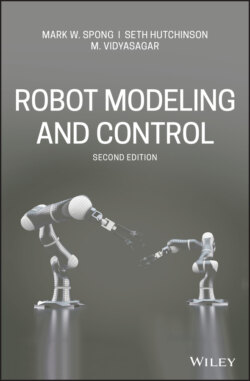Читать книгу Robot Modeling and Control - Mark W. Spong - Страница 60
2.4.1 Rotation with Respect to the Current Frame
ОглавлениеRecall that the matrix in Equation (2.9) represents a rotational transformation between the frames o0x0y0z0 and o1x1y1z1. Suppose we now add a third coordinate frame o2x2y2z2 related to the frames o0x0y0z0 and o1x1y1z1 by rotational transformations. A given point p can then be represented by coordinates specified with respect to any of these three frames: , , and The relationship among these representations of p is
(2.13)
(2.14)
(2.15)
where each is a rotation matrix. Substituting Equation (2.14) into Equation (2.13) gives
(2.16)
Note that and represent rotations relative to the frame o0x0y0z0 while represents a rotation relative to the frame o1x1y1z1. Comparing Equations (2.15) and (2.16) we can immediately infer
(2.17)
Equation (2.17) is the composition law for rotational transformations. It states that, in order to transform the coordinates of a point p from its representation in the frame o2x2y2z2 to its representation in the frame o0x0y0z0, we may first transform to its coordinates in the frame o1x1y1z1 using and then transform to using .
We may also interpret Equation (2.17) as follows. Suppose that initially all three of the coordinate frames coincide. We first rotate the frame o1x1y1z1 relative to o0x0y0z0 according to the transformation . Then, with the frames o1x1y1z1 and o2x2y2z2 coincident, we rotate o2x2y2z2 relative to o1x1y1z1 according to the transformation . The resulting frame, o2x2y2z2 has orientation with respect to o0x0y0z0 given by . We call the frame relative to which the rotation occurs the current frame.
Example 2.5.
Suppose a rotation matrix represents a rotation of angle ϕ about the current y-axis followed by a rotation of angle θ about the current z-axis as shown in Figure 2.8. Then the matrix is given by
(2.18)
Figure 2.8 Composition of rotations about current axes.
It is important to remember that the order in which a sequence of rotations is performed, and consequently the order in which the rotation matrices are multiplied together, is crucial. The reason is that rotation, unlike position, is not a vector quantity and so rotational transformations do not commute in general.
Example 2.6.
Suppose that the above rotations are performed in the reverse order, that is, first a rotation about the current z-axis followed by a rotation about the current y-axis. Then the resulting rotation matrix is given by
(2.19)
Comparing Equations (2.18) and (2.19) we see that .
